Supermicro Ultra SYS-120U-TNR Review: Testing Dual 10nm Ice Lake Xeon in 1U
by Dr. Ian Cutress on July 22, 2021 9:00 AM ESTSystem Results and Benchmarks
When it comes down to system tests, the most obvious case in point is power consumption. Running through our benchmark tests and the IPMI does a good job of monitoring the power consumption every few minutes. We managed to see a 747 Watt peak listed, however the graph to run a few quick last photos for this reviews is showing something north of 750W.
750W for a fully loaded dual 28C 2x205W system sounds quite high. This system has a peak of 1200W on the power supply, so that leaves 500W for an AI accelerator and anything additional. This means a good GPU and a dozen high power NVMe drives is about your limit. Luckily that's all you can fit into the system. Users who need 270 W processors in this system might have to cut back on some of the extras.
One of the elements in which to test this system at full power, and if we look at the processor power consumption we get about 205 W per processor (which is the rated TDP) during turbo.
Out of this power, it would appear that the idle power is around 100 W, which is split between cores/DRAM (we assume IO is under DRAM?). When loaded, extra budget goes into the processors. We see the same thing on CineBench, except there seems to be less stress on the DRAM/IO in this test.
Benchmarks
While we don't have a series of server specific tests, we are able to probe the capability of the system as delivered through mix of our enterprise and workstation testing. LLVM compile and SPEC are Linux based, while the rest are Windows, based on personal familiarity and also our back catalog of comparison data. It is worth noting that some software has difficulty scaling beyond 64 threads in Windows due to thread groups - this is down to the way the software is compiled and run. All the tests here were all able to dismiss this limitation except LinX LINPACK, which has a 64 thread limit (and is limited to Intel).

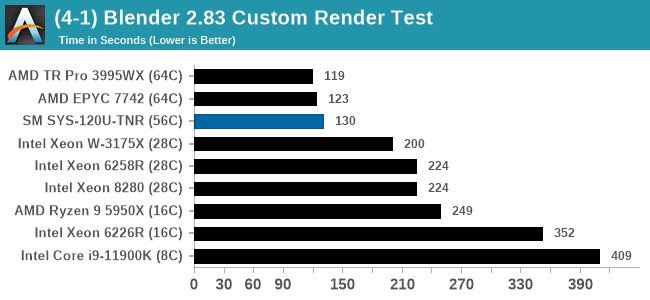
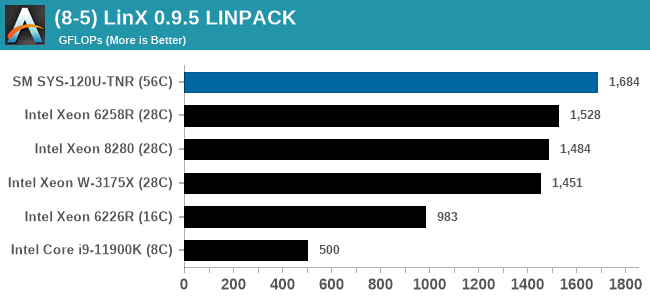
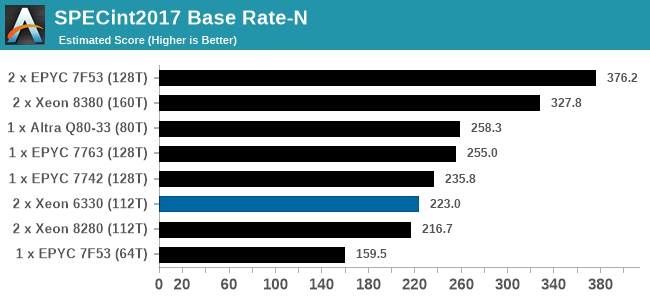
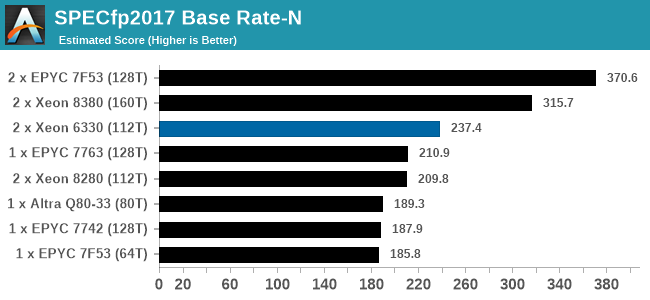
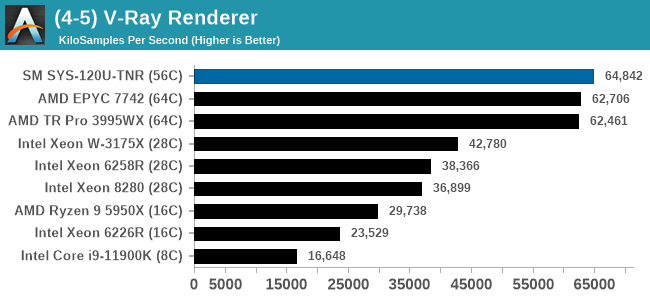
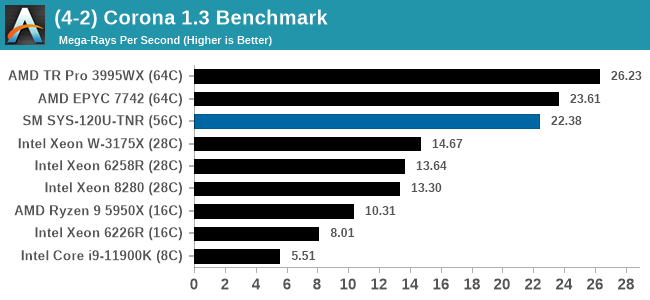
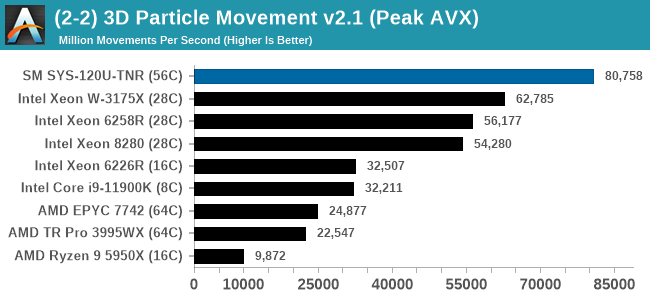
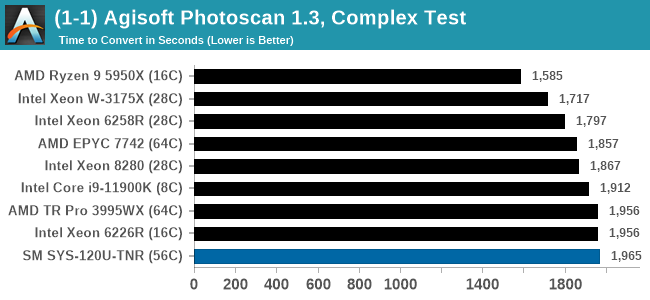
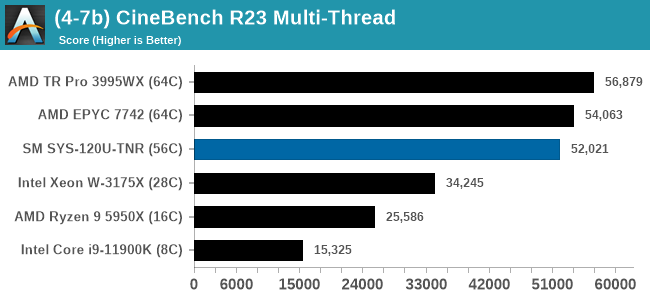
In almost all cases, the dual socket 28C SYS-120U-TNR sits behind the single socket 64C option from AMD. For the tests against dual 8280 or dual 6258R, we can see a generational uplift, however there is still a struggle against a AMD's previous generation top tier processor. That said, AMD's processor costs $6950, whereas two of these 6330s is around $3800. There is always a balance between price, total cost of ownership, and benefits versus the complexities of a dual socket system against a single socket system. The benchmarks where the SYS-120U-TNR did the best were our AVX tests, such as 3DPM and y-cruncher, where these processors could use AVX-512. As stated by Intel's Lisa Spelman in our recent interview, "70% of those deal wins, the reason listed by our salesforce for that win was AVX-512; optimization is real".


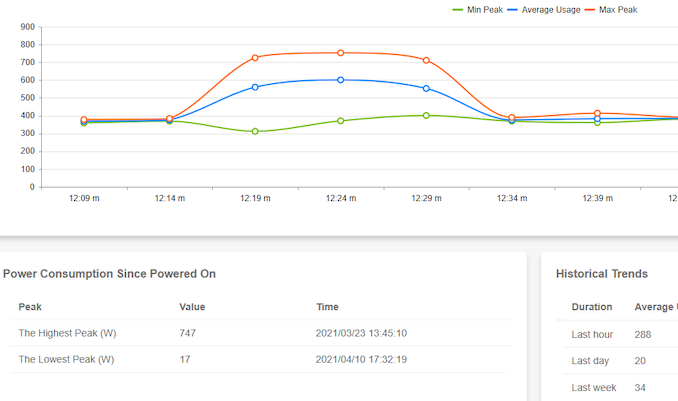
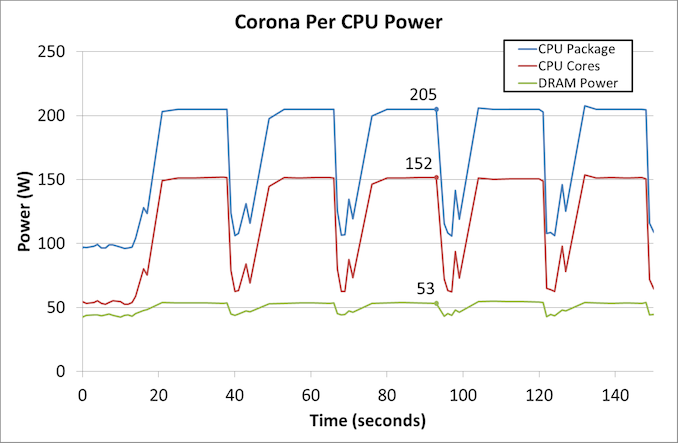
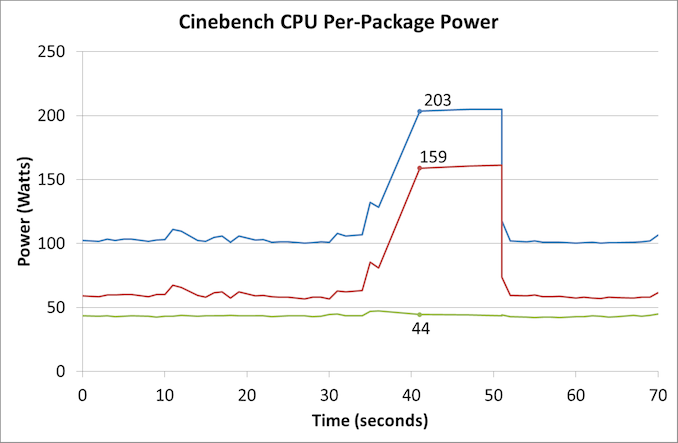








53 Comments
View All Comments
domih - Thursday, July 22, 2021 - link
Forgot to mention: the testing/benchmark is done with the software that will run on the systems once acquired, not synthetic/generic benchmarks which you might use at the beginning to validate the systems. 90+% of the testing is done with production / apps and load scripts to feed them.mode_13h - Friday, July 23, 2021 - link
Thanks.> you may select not the fastest system
Right, so it sounds like a lot for 70% of sales to hinge on performance, much less specifically AVX-512.
I guess where my skepticism comes from is in cloud scenarios where there's not just a single app the customer intends to run. In such cases, I don't know how you can say that AVX-512 made the deal, unless they use it as a generic answer to reservations the customer might raise about performance.
Also, I just can't see the case for many customers to even care about vector arithmetic. If you're running a web server, CI (Continuous Integration), or many databases, it's integer performance you're likely to care about. 70% of the workloads running on cloud & enterprise servers aren't even ones that benefit from AVX-512!
jospoortvliet - Friday, July 23, 2021 - link
Well, I'd say it is possible 70% of their sales wins relies on this one AVX-512 feature - but if you are right and it is only interesting for a minority of customers, that simply means they are not selling a lot... And indeed, if this argument goes away with AMD's next gen, that's even worse news.mode_13h - Saturday, July 24, 2021 - link
> that simply means they are not selling a lot...All of their BIG server processors since 2017 support AVX-512. And while the Datacenter Group's revenues are down, they're still the second-biggest profits among Intel's business units.
Spunjji - Monday, July 26, 2021 - link
@mode_13h - that's a very good point. Maybe it's one of those things where the buyer would have selected Intel anyway for ancillary reasons. but are offering AVX-512 as a rationalisation when given a limited range of options for providing feedback (which would imply it's the thing the sales guys are selling hardest).Spunjji - Monday, July 26, 2021 - link
That really does depend on the size / expertise of the customer / reseller involved.domih - Monday, July 26, 2021 - link
That too!Oxford Guy - Sunday, July 25, 2021 - link
AVX-1024!mode_13h - Sunday, July 25, 2021 - link
Sapphire Rapids has AMX, which is a little like AVX-8192. I think it'll be a big win for a few very specific cases, but less generally useful than AVX-512.Spunjji - Monday, July 26, 2021 - link
Niches within niches, but look how deep this niche goes!